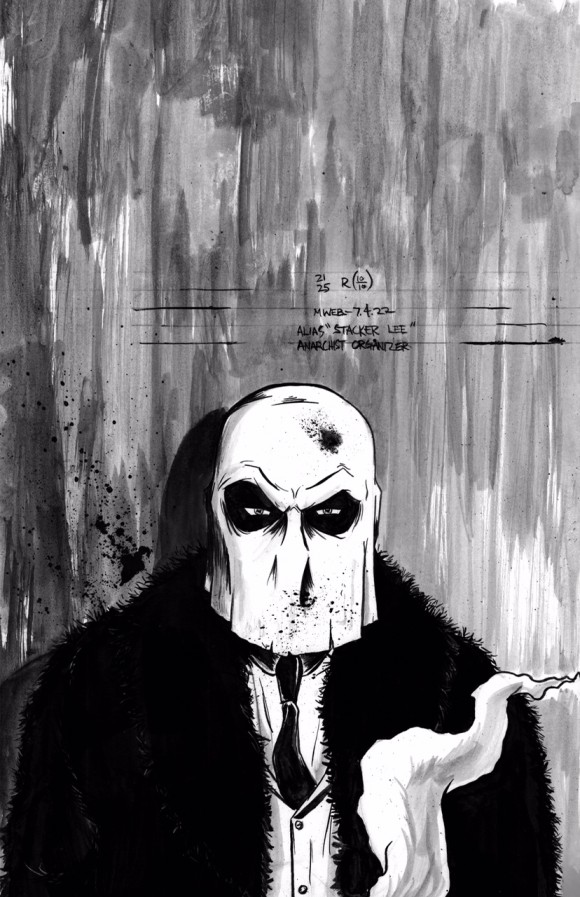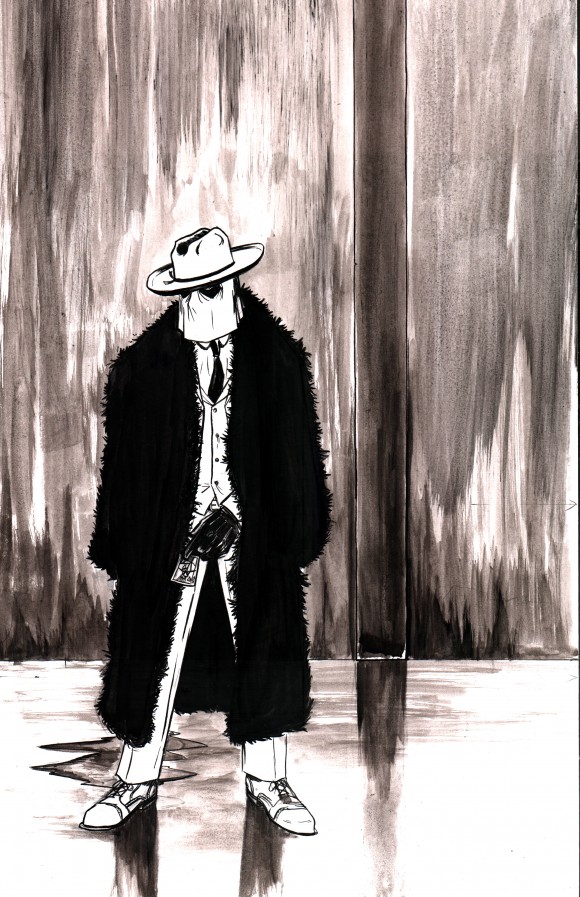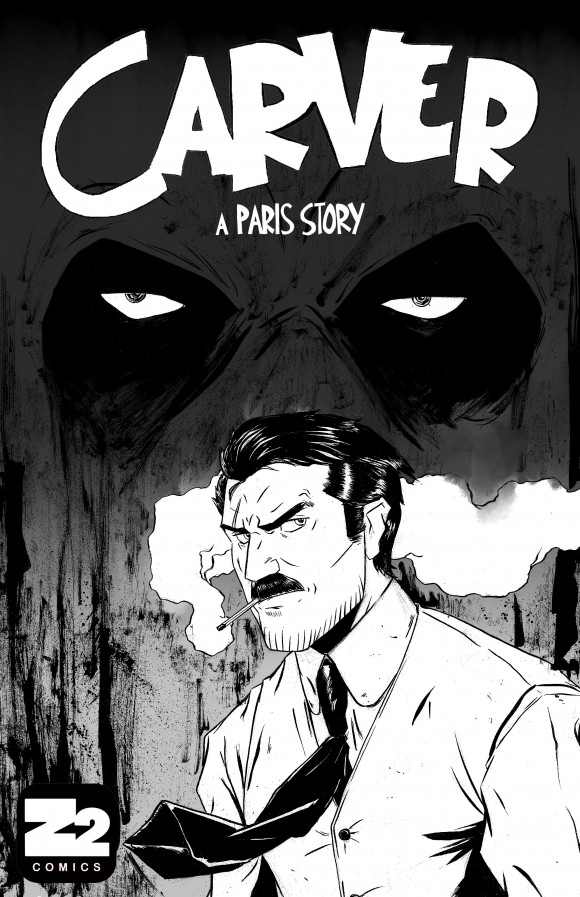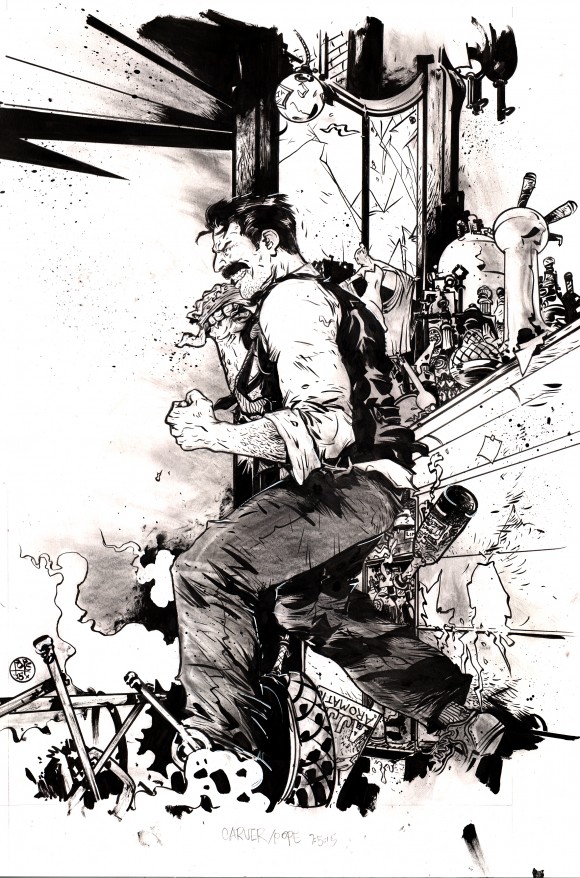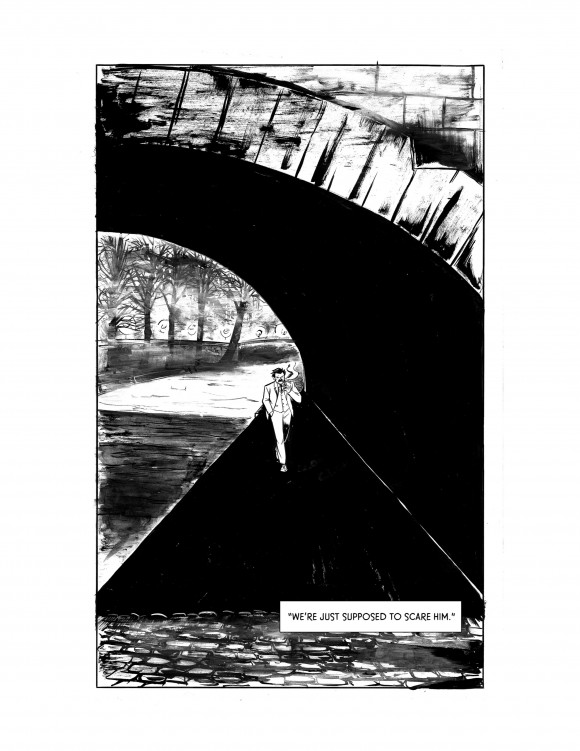WITH EXCLUSIVE ART! Creator Chris Hunt shares the story of his forthcoming Z2 Comics series, Carver, and discusses working under mentor Paul Pope.
By G.D. KENNEDY
The archetype of the man’s man is tried and true, the wandering adventurer who loves guns, whisky and women, and deigns anything he considers facile or weak. But despite its ubiquity, this is a character that quickly can become stale and one-note, an exaggerated “ideal” that is as empty as it is unrealistic. In his forthcoming series Carver — due in November as part of Z2’s new periodical line –– artist/writer Chris Hunt delves into this character of the “man’s man,” as his titular character Francis Carver is an Indiana Jones and Ernest Hemingway prototype. But rather than press the Carver deeper into the hardened mythos, Hunt reverts course, unwinding him to find to their source and the meaning behind the rough exterior. Carver is, in many ways, a throwback to European travel adventure comics, but it is more self-aware, cognizant of the characters and the meanings of their actions, with the true exploration of foreign space being the character himself as opposed to unknown lands.
Chris spoke with us about Carver and its first installment, “A Paris Story“, which is a strikingly personal, and one that Chris has endeavored to publish in the face of a number of hardships. But beyond Carver itself, Chris’ story is fascinating for the story it tells about the challenges facing a young creator and the difficulties breaking into the industry, even for someone like Chris who, while ostensibly an outsider, has the backing of friend and mentor Paul Pope, one of the most highly regarded independent creators working now. So now I will turn things over to Chris:
G.D. Kennedy: Can you tell us a bit about Carver?
Chris Hunt: The easiest way to describe him and the story would be to say Carver is my Indiana Jones in the 1920s, with more whisky and more . . . morally ambiguous characters. Including the protagonist himself. Carver is a throwback to the kinds of stories I loved growing with up as a boy.
Francis Carver is something of an infamous Gentleman of Fortune in the early 20th Century. He’s been hopping around the world for about 5 years seemingly just chasing easy money, but he has to put the brakes on after he’s beseeched by an old flame for assistance in a grave matter. This ultimately means returning to Paris, a city he’s been trying to distance himself from as much as possible. If you’ve read the European author Hugo Pratt’s Corto Maltese series, that was the biggest inspiration for me directly as a comic creator. Where as Corto is this dark, suave rogue with a heart of gold, I figured the American version would be quite uncouth, and truly without his moral compass. You can look at him and just assume the kinds of crazy cliche things that are definitely a part of his backstory, but this first Carver story isn’t actually focusing on a high adventure. It’s actually exploring what would drive a person to become the kind of man we meet at the beginning of this tale, and whether we would in fact really want to trade places with a person like that.
G.D.: Francis Carver, the titular character, is billed as a classic “man’s man,” a rugged hero in the vein of Teddy Roosevelt and Ernest Hemingway at their most masculine. What sets Carver and the story that you intend to tell apart from prior iterations of this classic character?
Chris: The man women want, and that men want to be. Hahaha. He is all those things, or I should say, he has become all of those things. Here’s the thing though, as much as I love both Teddy and Ernest, both being two very apt references, it’s a bit challenging to separate the men from the legends that have sprung up around them. Carver is basically the guy Hemingway thought he was. Francis has no ego in what he’s become, it’s just an effective way to navigate the world he has come to occupy, and I think that’s the big divergence that Carver takes as a character from these other works of fiction.
I’m basically calling BS on the archetype itself. “A Paris Story” is about learning what drives a man like Carver, and at this particular moment in history. He’s damaged when we meet him, but he will be broken before the story is over and you will see him shed tears. That’s something I knew would be there from the beginning. He has to break character, because that’s what he views himself as. He’s an actor in a violent, tragic play wearing a mask. My hope is that by the end of issue 5, though he’ll still be wearing the mask, a small amount of light will have been shed on him as a character and the audience will be able to see him for more than just a worn out trope, but as a worn out human being, because let’s face it, we all wear masks to some degree. There will be resolution to the this story arc as well, I’m not going to pretend that he isn’t the protagonist, but in the world of Carver, everything comes at a price and resolution is only temporary.
G.D.: Everything you’ve written about Carver reflects that this is an incredibly personal endeavor for you. Why is this story so important to you? Where does it come from?
Chris: Initially Francis was just a character I called The Hunter in one of my early stories I drew, that sprang from my fascination with Hemingway and his big game hunting stories from Africa. I was actually in France having my first experience with a great romance abroad, when I came up with the idea for the first story, and in the back of my mind I knew that Paris would be a part of his backstory in some way.
When I sat down to write what I thought was going to be a graphic novel at the time, I chose to revisit the character and base it on my experience with the girl I had been with while in Paris. The plan was to start it in March of 2011, but coincidentally, two of my best friends died suddenly a month and a half apart from each other, starting in March. It changed just about everything in my life, and how I’d navigated my existence up to that point. It took me a while to bounce back from that year, and I didn’t put any pressure on myself to produce anything more than surface level work for hire stuff for quite some time. I was still digesting what had happened. This happened right at a time when my career was first gaining some momentum, too, but I just didn’t have it in me. I was in survival mode for well over a year, and I wouldn’t say I was surviving well, when I look back on it. By the time I did sit back down in earnest though, the story had changed for me. What was once just a story about a love lost, became a story about loss in general and the road back from that. Well, more specifically, it became the desire to answer for myself if there was a way back from that. Still working on that one.
G.D.: The first installment of Carver is set in Paris, and as I understand it the character has a bit of an adventurous, jetsetting lifestyle, in the vein of Indiana Jones and Corto Maltese. Where else is Carver going to take us? What would Carver’s ideal Paris trip look like?
Chris: I’d say that Carver is a bit of a wanderer like myself. There are still so many places in the world that I want to visit and experience. There’s a great quote I came across from Pratt that reads, “For me, my travels have been the chance to go to a place that already exists in my imagination.” That’s what it was like visiting France for me in 2010. It wasn’t just as I had imagined it, but it was a place I’d always known I’d visit, so it felt familiar already.
If I were to keep to that vein, I’d say Africa or the Middle East would be the next place you’d see Francis chronologically after this first story. I do want to tell a story with Francis working out in the Western Cascades sometime after his experience in WWI, based on my own experience doing trail work out there. Like Corto or Indy, if you go a decade in either direction on the timeline (A Paris Story takes place in 1923) you’re hitting some very pivotal shifts both politically and economically in the world. Any major arc like what I’m doing with Paris Story really will be focusing on this path of redemption Francis is on, so where he’s at will simply serve as a familiar backdrop, most likely in juxtaposition with the kind of man he is. He’s not a city guy when you meet him in Paris. It’d be like keeping a lion in the city as a pet. Eventually something bad’s going to happen when you cage something like that long enough. You’ll see some flashbacks, and backups that allude to him as adventurer but that’s not the focus I’m placing on him as a character. It’s kind of like Reservoir Dogs is a movie centered around a heist that you never really see.
I don’t know if Francis would be that enthralled with the Paris of today. He’d probably be sitting quietly in Harry’s New York Bar keeping to himself. I think he’d do as I did and wander a lot and just take as much in as possible. When no one was looking though, he’d sneak into La Musee d’Orsay. He was an artist once upon a time after all!
G.D.: Personally, I’m fascinated by the anarchist movements that sprung up in the U.S. and Europe in the early 20thCentury, when Carver takes place. Your antagonist, Stacker Lee, is billed as the leader of an anarchist group. Why did you pick this as an element of your villain?
Chris: I thought anarchy was an interesting philosophy to apply to a villain, because it essentially means that they’re unpredictable in all ways. Including to themselves. Since Stacker Lee is subject to his own whims and desires, both of those could change at any moment, so the people around him as well as the reader would have a hard time predicting his behavior. He’s the ultimate villain in my mind because he’s not only the hero in his own story, but he can back it up by the way he’s rationalized his philosophical stance. He’s got a strong grip on the darker parts of Paris. I’d compare Stacker’s organization to The Bonnot Gang that was operating around 1911 in Paris. You don’t see much of Stacker as The Boss Hogg of Paris, but that’s essentially what he is.
Like I’ve said previously, all of the research I did for Carver’s backstory was just so that I could pepper clues here and there, and hopefully round him out as a “complete” person to the best of my abilities. Stacker was no different. I’ve had a fascination with anarchy as a philosophical ideology for a while, but that was in a more contemporary sense and strictly as an intellectual exercise. I was pretty unfamiliar with the many varied offshoots that sprung up in the Europe in the early 20th Century, particularly that of Illegalism. I mean, Illegalism was a philosophical stance that was predicated upon the notion that those subscribing to it required no underlying moral foundation. They just straight up did what they wanted to, when they wanted. They were robbing banks, breaking into people’s houses, you name it. It got so bad that the other anarchist groups were like “They’re not with us,” and officially condemned them in 1913. My version of events is slightly different in Carver, in that the Illegalists survived well past the first World War.
G.D.: Carver was recently picked up by Z2 comics, after you’d been attempting to fund publishing through Patreon.com. Can you tell us a bit about the journey to getting Carver picked up and published?
Chris: As I developed Carver I pitched it around to different publishers on the off chance that anyone was interested. The rejections were pretty encouraging actually. Pretty much across the board I was told that they liked the story and the art, but that I had few things working against me. With few exceptions, no one is really attempting to do an adventure comic, and they certainly aren’t trying to do it in a way that treads so close to a European aesthetic. Which puts me at two disadvantages straight out of the gate, which inevitably lead to their third point, which was I had no name recognition, so therefore they wouldn’t take the risk on me.
To me, it was kind of funny, actually, that they were turning down an idea they themselves said was good. I will admit though, I was terrified by the idea that someone that did have name recognition would suggest a similar idea to a publisher and, in turn, beat me to the punch. That lead me to Patreon. Partly so to plant a flag in the sand and start releasing this story in some kind of public forum and also to try and finance the project in some small way. Not long after I got the Patreon up and running though, I started talking to Z2’s Josh Frankel in early 2015 and over the course of a few months we started talking about the possibility of Carver making its home with his company.
G.D.: There is a10-minute Carver short film (found here) that you’ve already put out. What was your role in the short? How does the movie fit into the comic? Do you anticipate any more Carver movies?
Chris: I partnered with my good friend Ron Torres to produce the short with him at the helm as director. Our budget was pretty minuscule so he and I ended up wearing a lot of different hats. I was the executive producer, all the way down to costume designer, location scout – I mean you name it, he and I did it. Ron and I both worked for free, but made sure to pay everyone else something, so I guess you could say we did all of the jobs we couldn’t afford to pay others to do. I even ended up playing the main character, too, just because we couldn’t afford to compensate anyone for the amount of time and punishment that would be required for the role. As an example, I spent 6 months just learning how to fight, and in the process got my nose broken for sure one time, possibly two. I figured something like this would happen and I really couldn’t deal with the idea of putting someone else into harm’s way.
As far as where it falls in the Carver canon, it does occur before the events of the comic. The goal was to broaden the boundaries of the universe’s sandbox a bit, and make you feel a bit more familiar with the universe. Plus not everyone reads comics, but most people will watch a short film with a fight scene in it. So the thought was that maybe somebody who watched the short would enjoy the story and characters enough to check out the comic. Kray, the mute albino Basque assassin that Carver fights, will pop up in the next arc if I get the chance to keep going.
I certainly hope we can make more, but for now though I’m just focusing on the comic. I still have my mustache though so who knows!
G.D.: You served as a resident artist at the Atlantic Center for the Arts, where you studied under Paul Pope, who I understand was one of your favorite artists as kid. How did you end up with this residency? What was it like working with (or under) Pope?
Chris: Paul Pope’s THB was the first comic I ever read, so it’s been a real treat to be able to call him a friend, and have the chance to learn from him. He and I had been friends for a while by the time he got the residency at Atlantic Center for the Arts. He mentioned it to me, and encouraged me to apply, but I didn’t assume that meant I had some home-court advantage. Paul has a lot of integrity and I know for a fact if I had just phoned my application in, he’d have had no problem slotting someone in had who worked harder, and was hungrier. My experience at ACA was just nothing short of life changing. That is an amazing institution run by some of the most dedicated and kind individuals, and I am eternally grateful to them for providing me and the other residents the chance to learn in such an environment. Interestingly enough, the story I submitted as a part of my application was the first Carver story.
G.D.: What did you learn from Pope, both as working in the industry as a professional, and as an artist?
Chris: Well, you see only so far because you stand on the shoulders of giants, as it was said. It’s creators like Paul that helped bridge the gap between the staunch independent creators of the 90s with the mainstream. He showed it was possible to occupy both worlds seamlessly.
I think the most important thing I’ve ever gotten from Paul wasn’t something that he told or showed me directly. I remember by the end of that first THB I read, I had already decided that I wanted to do what this guy did. Reading THB set me down a path in my life that has led to this moment, this interview in fact. I can remember exactly where I was when I read that book. What the room looked like, even what it smelled like. I never forgot it, as hard as I tried, and I did try a couple times. To be honest that’s what blows my mind more than anything. I got to meet the person who inspired a 22 year journey I’ve been on.
Ultimately learning from Paul, working with him, and now collaborating with him as we did on our Vertigo short 1vA for Strange Sports is a constant reminder of what hard work and clear vision will get you if you can just keep going and believe in yourself.
G.D.: I saw that you recently wrote about attempting to gain a foothold with mainstream publishers like Marvel, DC and Dark Horse, and how you decided to turn your focus to your own stories, like Carver. What resulted in the decision to change your focus? What was this experience like?
Chris: Well, at the end of last year I basically found myself in a situation that I didn’t feel comfortable with at one of the larger publishers. It mostly came down to contracts and ownership. I don’t want to get too specific, but I will just say I was struggling with the fact that I was being presented with something that seemed fundamentally wrong to me. I was also being told that it was the nature of the business and if I couldn’t deal with it, that it would be the same wherever I went. The person telling me this is also someone I respect immensely, so it wasn’t really boycotting “The Man” or anything, I just recognized that I was unable to reconcile my concerns so I moved on. There wasn’t anything I was going to be able to do other than raise a ruckus that’s just not my style. I won’t lie and say that it wasn’t disheartening though. I really thought that was it and I’d just ride out New York until it’s time to go home, and I’d just create comics as a hobby.
G.D.: Moving to New York can be a difficult transition for anyone; I found it a challenge and was only coming from Philadelphia. You recently moved here from Idaho, which is a starkly different environment. How has your acclimation been? What are you doing besides working on comics to keep yourself busy?
Chris: Despite having visited a number of times over the years, it definitely was a challenge getting acclimated to the day to day of the place. It can be exhausting (as you know) just to do menial tasks that weren’t a big deal in a smaller place, like Boise, where I’m from. I found myself missing the environment a lot. I missed seeing the mountains in the distance. I miss being able to make a fire in the backyard. I miss my backyard. A lot of small things you take for granted. Even silence. The white noise still gets to me a lot here. Gets under my skin. But is such a wonderful place to explore and and wander through, and it’s obviously a cultural mecca in so many ways. The opportunity is just astounding in NYC. That is inspiring to me in a lot of way.
What arguably kept me sane for the vast majority of the time I’ve been here was having a part time job with Filson, at the store they opened up here. Filson is an old school North West work outfitter, and I wore some of their stuff when I was working in the Cascade mountains before I left Idaho for NYC. I was able to get a taste for home, while sharing my stories and first hand knowledge which really helped put me at ease. I was also able to make some friends there and I really got to know a lot of the people in the neighborhood, which also reminded me of home a lot. It felt very nostalgic to be walking down Lafayette or Bond, and have the firefighters wave, or hear Keith the UPS guy hollering at me from across the way. Now, though, I’m kind of just a comic book-making hermit. I’m hoping that at some point in early 2016 I can leave the neighborhood — hahaha.
G.D: Are you working on any other projects besides Carver right now? Anything you’re particularly excited about?
Chris: Carver is my primary focus right now for sure. I want to give it the best shot possible. After that, I have a giant robot story I’ve had kicking around for a while I’d like to do called 01-AD GO! After our collaboration for Vertigo, Paul and I are getting ready to start on another short for a pretty cool franchise that I unfortunately can’t name yet. I guess the hope ultimately is that Carver does well enough that we can extend it beyond the initial 5 issues!

